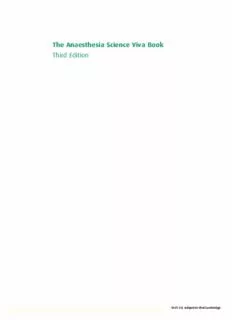
The Anaesthesia Science Viva Book PDF
Preview The Anaesthesia Science Viva Book
The Anaesthesia Science Viva Book Third Edition 10:07:26, subject to the Cambridge 10:07:26, subject to the Cambridge The Anaesthesia Science Viva Book THIRD EDITION Clinical Science as Applied to Anaesthesia, Intensive Therapy and Chronic Pain A Guide to the Oral Questions SIMON BRICKER TheCountessofChesterHospital, Chester,UK Medical illustrations by CELYN BRICKER 10:07:26, subject to the Cambridge UniversityPrintingHouse,CambridgeCB28BS,UnitedKingdom OneLibertyPlaza,20thFloor,NewYork,NY10006,USA 477WilliamstownRoad,PortMelbourne,VIC3207,Australia 4843/24,2ndFloor,AnsariRoad,Daryaganj,Delhi–110002,India 79AnsonRoad,#06–04/06,Singapore079906 CambridgeUniversityPressispartoftheUniversityofCambridge. ItfurtherstheUniversity’smissionbydisseminatingknowledgeinthepursuitof education,learning,andresearchatthehighestinternationallevelsofexcellence. www.cambridge.org Informationonthistitle:www.cambridge.org/9781316608814 DOI:10.1017/9781316651841 Firstedition©GreenwichMedicalMedia2004 Secondedition©SimonBricker2009 Thirdedition©SimonBricker2017 Thispublicationisincopyright.Subjecttostatutoryexception andtotheprovisionsofrelevantcollectivelicensingagreements, noreproductionofanypartmaytakeplacewithoutthewritten permissionofCambridgeUniversityPress. Firstpublished2004 Secondedition2009 Thirdedition2017 PrintedintheUnitedKingdombyClays,StIvesplc AcataloguerecordforthispublicationisavailablefromtheBritishLibrary. LibraryofCongressCataloging-in-PublicationData Names:Bricker,Simon,author. Title:Theanaesthesiasciencevivabook:clinicalscienceasappliedtoanaesthesia,intensivetherapy, andchronicpain:aguidetotheoralquestions/SimonBricker;medicalillustrationsbyCelynBricker. Description:Thirdedition.|Cambridge;NewYork,NY:CambridgeUniversityPress,2017.| Includesbibliographicalreferencesandindex. Identifiers:LCCN2017019176|ISBN9781316608814(pbk.:alk.paper) Subjects:|MESH:Anesthesia|ClinicalMedicine|StudyGuide Classification:LCCRD82.3|NLMWO18.2|DDC617.9/6076–dc23 LCrecordavailableathttps://lccn.loc.gov/2017019176 ISBN978-1-316-60881-4Paperback CambridgeUniversityPresshasnoresponsibilityforthepersistenceoraccuracy ofURLsforexternalorthird-partyinternetwebsitesreferredtointhispublication anddoesnotguaranteethatanycontentonsuchwebsitesis,orwillremain, accurateorappropriate. Everyefforthasbeenmadeinpreparingthisbooktoprovideaccurateandup-to-dateinformationthatisin accordwithacceptedstandardsandpracticeatthetimeofpublication.Althoughcasehistoriesaredrawn fromactualcases,everyefforthasbeenmadetodisguisetheidentitiesoftheindividualsinvolved. Nevertheless,theauthors,editors,andpublisherscanmakenowarrantiesthattheinformationcontained hereinistotallyfreefromerror,notleastbecauseclinicalstandardsareconstantlychangingthroughresearch andregulation.Theauthors,editors,andpublishersthereforedisclaimallliabilityfordirectorconsequential damagesresultingfromtheuseofmaterialcontainedinthisbook.Readersarestronglyadvisedtopaycareful attentiontoinformationprovidedbythemanufacturerofanydrugsorequipmentthattheyplantouse. 10:07:26, subject to the Cambridge To Imogen 10:09:14, subject to the Cambridge 10:09:14, subject to the Cambridge Contents Preface tothe Third Edition page xiii Preface tothe Second Edition xv Preface tothe First Edition xvii 1 Advice onAnswering Clinical Science Viva Questions 1 TheClinical ScienceViva (Structured Oral Examination) 1 TheMarkingSystem 2 Appearanceand Affect 2 Oral Questions 3 Why Do They Have to AskThese Kinds of Question? 6 ABrief Historyof Anaesthesia’s InferiorityComplex 6 Strategies for AnsweringClinical ScienceQuestions 7 AndFinally:Information, Understanding and ‘Buzzwords’ 10 2 Anatomy and Its Applications 13 TheCerebral Circulation 13 Brain Stem Death Testing 16 TheInternal Jugular Vein 19 Ocular Anatomy 22 ThePituitary 26 TheAutonomic Nervous System 30 TheTrigeminal Nerve 32 TheNose 35 TheSensoryNerve Supplyto the Face 37 TheSensoryNerve Supplyto the Scalp 39 TheCervical Plexus 41 TheLarynx 43 TheInnervation of the Larynx 46 TheAnatomyoftheTrachea and Bronchi 48 TheSurface Anatomy of the Neck (PercutaneousTracheostomyand Cricothyroidotomy) 51 TheStellateGanglion 54 TheParavertebralSpace 56 ThePleura 59 TheMediastinum 61 Myocardial Blood Supply 63 Myocardial Innervation 66 TheIntercostal Nerves 68 vii 10:09:04, subject to the Cambridge Contents The Diaphragm 70 The Liver 73 The Spleen 76 The Blood Supplyto the Abdominal Viscera(theSplanchnic Circulation) 78 The CoeliacPlexus 80 The Blood Supplyto the Spinal Cord 82 The Lumbar Sympathetic Chain 84 The Anterior Abdominal Wall 86 The Innervation of the Inguinal Region 88 The BrachialPlexus 90 The Ulnar Nerve 94 The Radial Nerve 96 The Median Nerve 98 The Antecubital Fossa 99 The Arterial Supply of the Hand 101 AnatomyRelevant to Subarachnoid (Spinal) Anaesthesia 103 The Extradural (Epidural) Space 108 The Sacrum 112 The Blood Supplyto the Lower Limb 114 The Femoral Triangle 117 The Femoral Nerve 118 The Sciatic Nerve 122 The SensoryInnervation of the Foot 124 Cross-Sectional Areas of Interest (Eye, Neck, Lower Thoracic and Lumbar Regions) 126 3 Physiology 131 Pneumothorax 131 Control of Breathing 134 Apnoeaand Hypoventilation 138 Compliance 140 The Failing Lung 142 Bronchomotor Tone (Asthma) 146 Smoking andAnaesthesia 148 Non-Respiratory Functions of the Lung 150 One-Lung Ventilation (One-Lung Anaesthesia) 152 Pulmonary Oedema 154 Pulmonary Hypertension 156 Hypoxic Pulmonary Vasoconstriction (HPV) 157 The Oxygen–Haemoglobin Dissociation Curve 159 Hyperbaric Oxygen 161 Oxygen Toxicity 164 Pre-Operative Assessment of Cardiac Function 166 Mitral Valve Disease 168 10:09:04, subject to the Cambridge Contents Aortic Valve Disease 171 Oxygen Delivery 174 Sepsis 175 Central VenousPressure and Cannulation 179 Fluid Therapy 182 Massive Haemorrhage:CompensatoryResponses andManagement 186 Blood Groups 188 Complicationsof Blood Transfusion 191 Anaemia 194 Postpartum andMassiveObstetric Haemorrhage 197 Physiological Changes of Late Pregnancy Relevantto General Anaesthesia 199 Non-Obstetric Surgery in Pregnancy 202 Pre-Eclampsia 205 CirculatoryChangesatBirth (CongenitalHeart Disease) 207 Physiologyand Clinical Anatomy of the Infant and Neonate 210 Laparoscopy 214 TheProne Position in Anaesthesia 216 Intracranial Pressure 218 Cerebral Blood Flow 223 PostoperativeCognitive Dysfunction andDelirium 226 Intraocular Pressure 229 TheNeuromuscular Junction 232 PostoperativeNauseaand Vomiting 234 Obesity 237 ThePhysiology of Ageing 239 The‘Stress Response’to Surgery 242 TheGlucocorticoidResponse to Surgery 244 Adrenaline (Epinephrine) 246 5-Hydroxytryptamine (Serotonin) 248 Cytochrome(s)P450 251 Nitric Oxide 253 Plasma Proteins 255 Thyroid Function 257 Nutrition 259 Electroconvulsive Therapy 263 Pain Pathways 265 TheComplex Regional Pain Syndrome (CRPS) 267 Diabetic Ketoacidosis (DKA and HONK) 270 Spinal Cord Injury 273 Immunology (and Drug Reactions) 276 Latex Allergy 279 Jaundice 281 TheArterial Tourniquet 283 Arterial Cross-Clamping 286 ix 10:09:04, subject to the Cambridge Contents 4 Pharmacology 289 Mechanisms of Action of General Anaesthetics 289 Chirality 292 Propofol 294 Ketamine 296 Thiopental and Etomidate 299 Inhalational Agents:Sevoflurane 302 Inhalational Agents:Desflurane 304 Inhalational Agents:Isoflurane 306 Inhalational Agents:Xenon 307 Inhalational Agents:NitrousOxide 309 Inhalational Agents:Comparison with the Ideal 312 Neuromuscular Blocking Drugs (and Sugammadex) 316 Suxamethonium 320 Opiates/Opioids 322 Local Anaesthetics: Actions 326 Local Anaesthetics: Toxicity 332 Local Anaesthetics: Influenceson Onset andDuration 335 Bupivacaine, Ropivacaine, Lidocaine andPrilocaine 338 SpinalAdjuncts to Local Anaesthetics 342 Induced Hypotension 344 Clonidine (and Dexmedetomidine) 347 Antibiotics 349 Anticholinesterases 353 Anti-Arrhythmic Drugs 355 β-Adrenoceptor Blockers 360 Anti-Hypertensive Drugs and Anaesthesia 362 Hypotension andIts Management 364 Inotropes 367 Drugs Used in the Treatment of Nausea and Vomiting 370 Drug Overdose:Prescribed and Therapeutic Drugs 373 Recreational Drugs and Drugs of Abuse 377 Drugs AffectingMood 380 Drugs AffectingCoagulation 382 Tranexamic Acid 388 Cyclo-Oxygenase (COX) Enzyme Inhibitors 390 Magnesium Sulphate 393 Tocolytics (Drugs That Relax the Uterus) 395 Uterotonics (Drugs That Stimulatethe Uterus) 397 Drugs Used in Parkinson’s Disease 399 Target-ControlledInfusion (TCI) 403 Conscious Sedation 408 Drugs Used to Treat DiabetesMellitus 410 Chemotherapeutic (Cytotoxic) Drugs 414 Bioavailability 416 Pharmacogenomics 418 10:09:04, subject to the Cambridge
